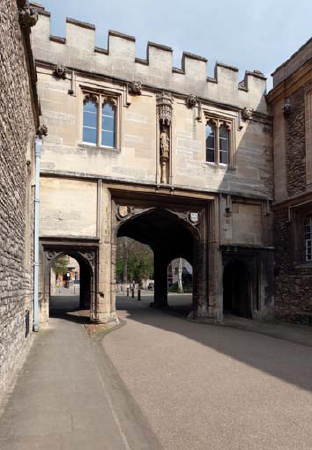
DESPITE LIVING APART, monks were not entirely cut off from the outside world. Many visited local towns or other abbeys and some went on pilgrimage. Others played a wider role within the church, such as when the Carthusian monk, Hugh of Avalon (c. 1135–1200), became Bishop of Lincoln in 1186, or the sacrist of Bury St Edmunds was elected Abbot of Thorney Abbey in 1217 (Benedictine: Cambridgeshire). At a personal level, while the Carthusians forbade monks from leaving their monasteries for home visits, the other Orders were not as rigid. Thirteenth-century monks at St Albans Abbey were permitted ‘home visits’ to see sick or dying relatives, but only for short periods and if accompanied by a colleague. Towards the end of the Middle Ages, however, these rules were relaxed further and monks were also allowed to pay social visits to their families and friends.
Conversely, visits from family members were tolerated. At Beaulieu Abbey a monk’s family was permitted to visit once or twice a year and to stay two nights on each occasion. There were similar arrangements at Abingdon Abbey (Benedictine: formerly Berkshire, now Oxfordshire). In the early fifteenth century the cellarer at Westminster Abbey allocated 200 gallons of ale each year for family visits.
Even if they had wished to, monks could not avoid the problems that flared outside their walled enclosures. Some abbeys in the north of England were damaged during wars between England and Scotland, while in Wales the crops and estates of several Cistercian monasteries, including Valle Crucis (Denbighshire, Wales), suffered during the Welsh wars of Edward I, eventually receiving reparation payments from the crown. Later still the abbeys of St Albans and Stratford Langthorne were among those vandalised during the Peasants’ Revolt of 1381.
Monks in larger monasteries also kept in touch with political affairs as important visitors came and went. Matthew Paris (c. 1200–59), a thirteenth-century monk at St Albans Abbey, corresponded with important people during the writing of his History of England and had long conversations with Henry III, while John Stone, a monk at Canterbury Cathedral Priory between 1417 and 1472, kept a chronicle in which he recorded that he saw a camel when the patriarch of Antioch visited the city in 1466.
Some Benedictine cathedral priories maintained their own colleges at Oxford University to which monks were sent. In 1437, a college for Cistercian monks was also founded in the same city. After the Dissolution, some of these college sites were reconstituted under different names; thus Durham Cathedral College (Benedictine) became Trinity College and St Bernard’s College (Cistercian) became St John’s.
Abbots of richer monasteries also played important roles at court and a few were summoned to medieval parliaments.
Local disputes such as clashes with tenants are recorded, with riots at Bury St Edmunds in 1327 which saw the abbot kidnapped; there was also an extraordinary event at Colchester Abbey (Benedictine: Essex) in 1272 when monks removed the body of a thief from the gallows and attempted to persuade the coroner that it was the corpse of an innocent man who had been slain by townspeople during a fight with abbey servants during the Midsummer fair.
Sometimes trouble broke into the cloisters. In the fourteenth century a thief was caught after sneaking into the infirmary at Chertsey Abbey (Benedictine: Surrey) – during the ensuing struggle one of the monks, who was also a priest, climbed out of his sick-bed, seized a sword and struck the robber who subsequently died. An investigation cleared him of any wrongdoings after it was decided that the intruder had probably died as a result of wounds inflicted by servants who had also joined the fight.

The fifteenth-century gatehouse of Abingdon Abbey (Benedictine, Oxfordshire).
Natural disasters were never far away: many monasteries suffered from flooding and famines, and from the fourteenth century onwards plague epidemics were a recurring fear. At Meaux Abbey, for example, the abbot and twenty-two monks died within a few weeks of one another in August 1349 as the ‘Black Death’ swept northwards.